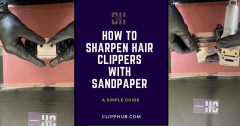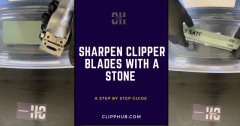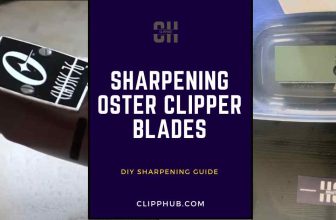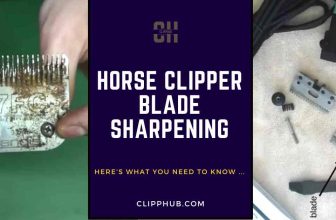
Andis is a popular brand that produces great hair clippers.
But over time, their blades can become blunt, and eventually, they need sharpening.
But how do you sharpen Andis’s clipper blades?
In this guide, I’ll walk you through both flat-blade sharpening and hollow-blade sharpening.
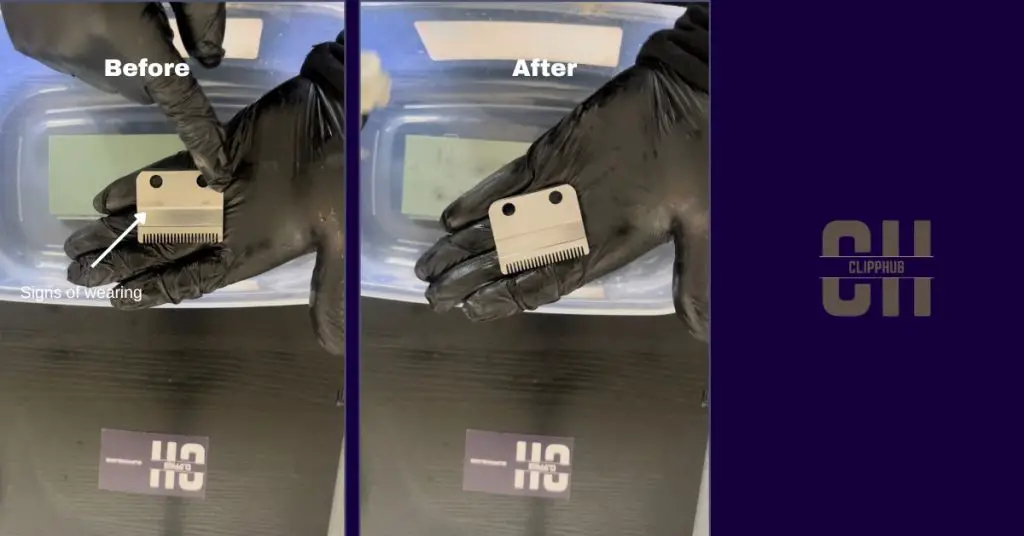
You’ll also understand why both are important as well as what you should always look out for before sharpening your blades
So with that said let’s get into it.
How to Sharpen Andis Clipper Blades At Home
Sharpening Andis hair clippers at home is an easy procedure and I outline the steps below.
These steps are for sharpening detachable blade Andis clippers.
These types of blades look like this:
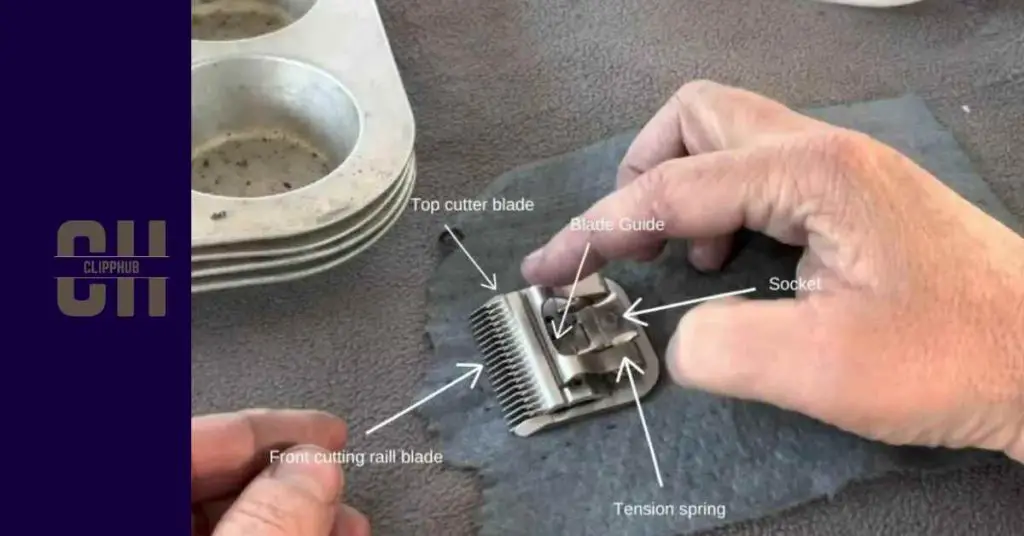
On the other hand, if you have lever blades, the right resource is later on in this article, so keep scrolling.
Do this process for both blades. Then clean them off and look to put them back together.
This is a brief outline of how to sharpen detachable Andis Clipper blades.
Later on in this article, I’ll go through this process in more detail.
But what if you don’t have detachable clipper blades?
If your clippers have a lever (Andis Masters for example),
Then check out one of the two articles below on how to sharpen those blades with sandpaper or a grindstone.
How To Sharpen hair clippers with sandpaper (Full Guide)
How to Sharpen Clipper Blades With a Stone (Step-By-Step)
Detachable Andis clipper blades are close-cutting and high-precision blades.
So you should look to sharpen your clipper blades but only when necessary.
In fact, you should even take them to get professionally sharpened every now and then…
We’ll talk about this next.
How do I know if my hair clipper blades need sharpening?
The method of sharpening I outline above and below in more detail is flat surface sharpening.
Flat surface sharpening is a boost you can give to your clippers at home when they show the #1 sign of a blade in need of sharpening (we’ll get to this later).
But there’s a reason professional blade sharpening is important, that’s because flat blade sharpening doesn’t give blades a natural hollow that’s needed to really make them sharp and highly effective.
In order to do hollow blade sharpening, you’ll need to do a grinding wheel. These wheels are expensive but they have a unique property that allows them to create a “hollow” in a blade.

These sharpening wheels have a slight slant to them.
When a blade is passed over this wheel it creates a hollow on the blade that’s hard to notice if you don’t know what you’re looking for, but your blade gets this shape:
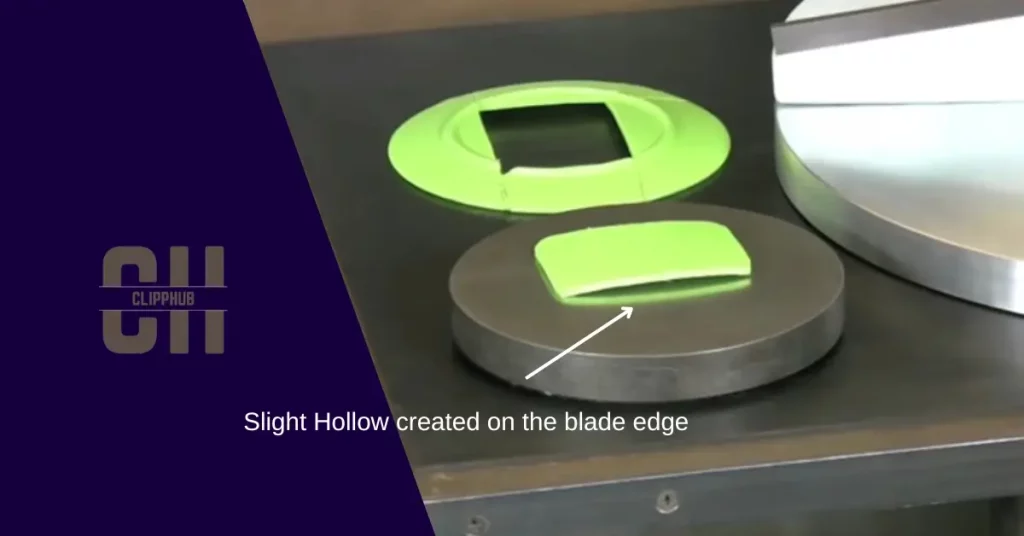
That curve is a “hollow”. The plastic is exaggerated, it’s not as obvious as this but if you were to look at your blades very closely you’d find they have this shape.
The degree to which this hollow is formed depends on the:
- Sharpening angle
- Pressure was applied while sharpening
- The duration of sharpening
What are the benefits of this?
This intentional unevenness serves a purpose. When the edges of your blade(the lowest point of the blade), make direct contact with the hair or fur being cut, the sloping effect helps guide the cut material to the center of the blade(the “highest” point of the blade).
The unevenness of the hollow ground blade helps with efficient hair capture and cutting. As the clipper moves through the hair, the center of the blade, which is the sharpest and highest point, does the bulk of the cutting.
The sloping sides of the blade guide the hair towards the center, ensuring a smooth cutting action and preventing the hair from getting caught or pulled.
Flat sharpening which is the method outlined in this guide, is more of temporary blade sharpening that will definitely sharpen up your blades, but if you keep doing it over many years, your blades will lose their natural hollow and become flat, meaning your blades will very dull and won’t cut at all.
But don’t do it more than 3 times before visiting a professional blade sharpener to get hollow back in your blades.
Proffesional blade sharpeners will know the right hollow for your blades and are a good investment for your blades’ longevity.
Search for one in your local area once you’ve flat-sharpened your blades a few times.
But again… don’t panic if can find a blade sharpener. Flat blade sharpening is effective enough to get your blades cutting better but if you want the best treatment for your blades visit a proffesional for hollow ground sharpening when you can.
Signs to not sharpen Hair clippers
Do not sharpen if your clippers are dirty. Yes, sometimes, people think just because their blades are a bit grimy they need sharpening. This is not the case.
Don’t confuse a dirty blade with one that is blunt. Yes, both can affect performance but how you fix it is key. If you just sharpen them at the slightest inconvenience, all you doing is thinning your blade further unnecessarily.
Look to clean and maintain your clippers, then if any of the real sign below appears it’s justified for you to sharpen your blades.
#1 Sign To Sharpen Hair Clippers
Hair clippers need sharpening when they pull hair.
Pulled hair is a sign that your blades are struggling to cut. From this point, you can look into it further and decide whether your blades need cleaning or sharpening.
Always clean and oil your clippers first. When you have done this and still notice hair pulling, then you can take your blades to a grindstone.
Check The Charge
Also, look into the plug and battery of your clippers. If you have a cordless hair clipper you most likely have a battery.
Batteries over a long period can wear out. The constant recharges over months and years mean that the clippers can become inconsistent in their level of power output.
Check your batteries are in top condition. A shortage of power can mean your clipper blades don’t move as quickly.
With corded Andis clippers, make sure your hair clippers are all the way plugged in. You’d be surprised how many times this has tricked people into thinking their blades are done for.
Always make sure the socket you plug your blades in outputs enough power to move your blades correctly.
Do your blades still pull hair? If your clippers still pull hair even after all of these checks, then you can get them sharpened. I will guide you in detail on how to do this later on by yourself, at home.
Detachable Blade Replacement
Sometimes, however, there are signs showing that your detachable blades need replacing.
These are:
Rough blades
If you run your finger over the blade and it’s very rough or gritty, it can be a sign that the blade needs to be sharpened.
However, if it’s very rough or even cuts you, you may need to get your clippers blades completely replaced or get them sharpened by a professional.
Chips/Rust
If you can see that the blades of your hair clippers are chipped, or have severe rust, then avoid sharpening them.

If your blades look anything like the image above, you’ll want to avoid sharpening your blades, it’s too damaged, and sharpening them for the first time may make it worse, Either resolve them or get them sharpened professionally as they need more than just sharpening.
The hollow ground is Completely Worn out
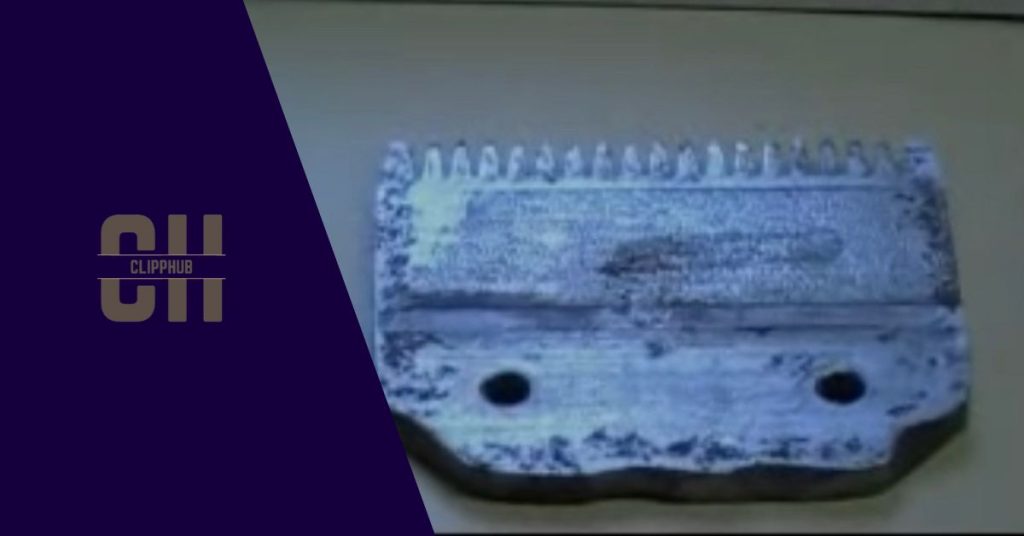
if your blades have flat sharpened too much (over many years), then they may look like this when you take them off.
If that’s the case you want to avoid sharpening..simply because there’s not much to sharpening. Your blade has been worn down as much as it could possibly go.
At this point, replacement if you only move.
Ideally
Ideally, when you remove your blades you want most of your blade to look clean, but still show certain signs of dulling and wearing like below:

If your blades look somewhat like this, then they’re good to be sharpened (Yes, it may vary but just make sure there isn’t too much damage on the blades).
But if you’re thinking of new blades, here are some Andis detachable blades.
You need to make sure Andis detachable blades need sharpening as in these steps, you’ll be:
- Changing the tension on your blade
- Changing the alignment of your blade
Both of these can lead to a major decrease in the performance of your clippers regardless of how sharp they are.
However that you should not put off if you have clippers need sharpening. I will guide you through the process so you can avoid these problems.
So, how exactly do you take apart Andis hair clipper blades? Don’t worry I talk about this next.
Sharpening Andis Clipper Blades
Yes, you can sharpen your Andis clipper blades but you must know how your blade fits inside your clipper.
Having this understanding helps with re-assembly after sharpening.
Detachable blades
Before you look to get into the steps you need to understand detachable blades and how they work as they can be complicated, especially for beginners.
Ivan Zoot explains the process well.
This video shows you how you can pop them off your clippers.
Detachable Andis clipper blades are propped up and held together by a tension spring. This has to be removed along with the socket, and blade guide.

To get to the blades themselves, you’ll need to remove and unscrew the screw bolt holding the socket to the top cutter. As shown below.
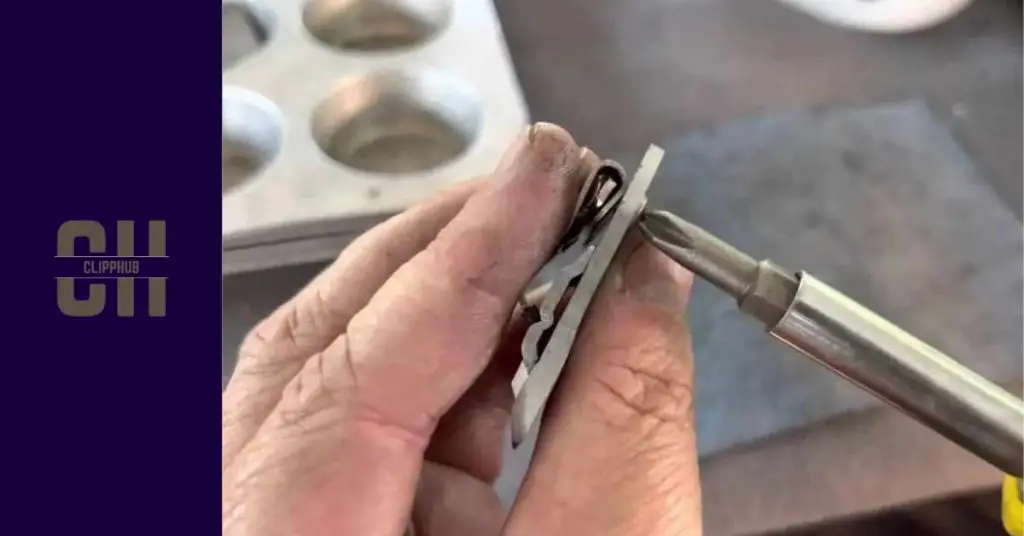
After doing this you should have access to both the top cutter and the top cutting rail blades.
But before you begin sharpening, be sure to keep the other parts of the blade in a safe place to make it re-seem easy after sharpening
Keeping these untouched (especially the tension spring) will make re-resembling easier after sharpening.
Now you know which type of Andis clipper blades are on your clipper, how to get access to them, and what to look out for, you can start the process of sharpening them.
I will also guide you on how to fit the blade back together as it can get complicated I will provide a step-by-step guide on how to do so.
But before this, you will need to have the right tools to begin this process, I provide them below.
Tool Needed To Sharpen Andis Clipper Blades At Home
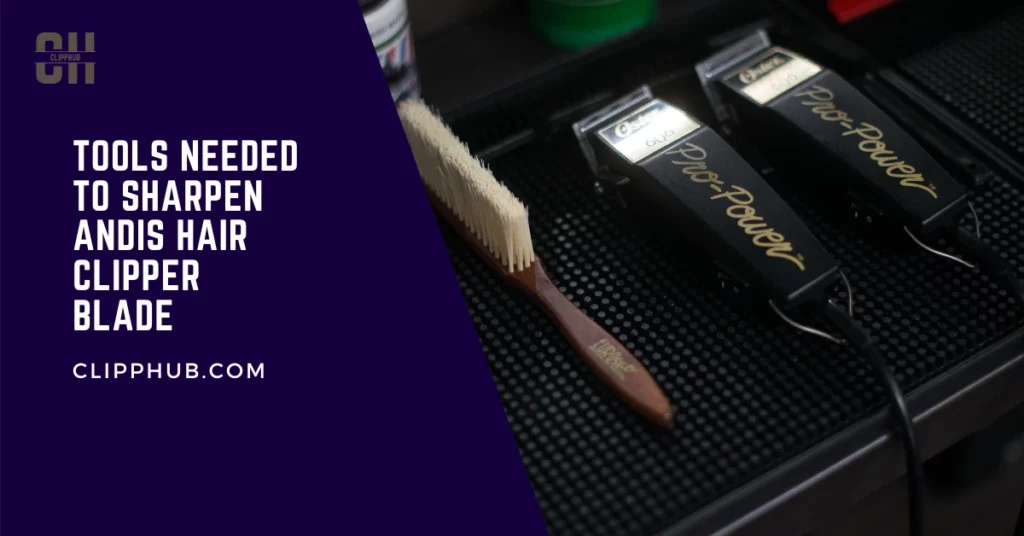
You need the right tools to sharpen your clippers correctly. Approaching this half-heartedly will lead you to well… mediocre results. We don’t want that.
Below I have a quick list of tools you will need to begin sharpening your clippers correctly.
- A small hard bristle brush ( It can be a toothbrush)
- A grindstone/ Sharpening stone ( 400 grit + 1000 grit grindstone)
- A screwdriver
- Cloth
- Blade wash
- Magnet
- A scale (optional)
- Hair clipper oil
Now you are equipped, let’s start sharpening your clippers with a grindstone at home.
Andis Clipper Blade Sharpening
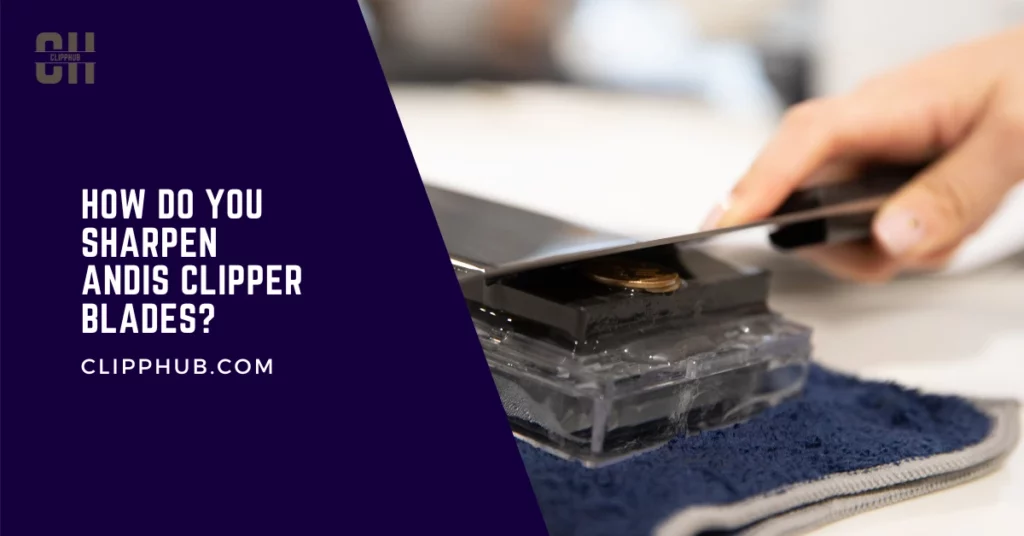
Step 1: Remove your hair clipper blades.
You will now need to resemble blades, You can simply do this by just unscrewing the blades but if you want to watch the process visually, the video below can give you some perspective.
Using your screwdriver, unscrew the two bolts that hold your hair clipper blades together.
This all depends on the type of clipper you have as I outlined above.
Take your time with this step and be careful when taking the blades out. Make sure not to hit or move the other components of your hair clipper.
Store other parts of the hair clipper blade in a safe space as they will be needed when putting the blade back together.
Step 2: Clean your blades
Always clean your clipper blades before you sharpen them.
Dirty clippers may be the reason your blades are not performing well, so deep clean your clippers, check how they perform, and then look to sharpen.
Using your brush make sure to brush away any dirt and hair that is on your clipper blades.
If your blades are really dirty, you can use blade wash and (gently) scrub any grime away, then dry them off with a cloth.
This:
- Makes it easier for you to sharpen
- Makes it clear when your blade is sharp
This step cannot be ignored it makes things a lot easier and it may solve your hair clipper problem all in one.
Step 3: Get your Sharpening stone ready
You’ll want to submerge your grindstone in water for 10-15 minutes.
This does one or two things:
- Gets the air bubbles out of the stone
- Makes the stone less rough.
Afterward, Place your grindstone on a flat surface with the 400 grit side up, facing up.
Step 4: Andis blade sharpening
You’ll be sharpening the interior of the blade facing the stone (the flat side).
To sharpen the best you can you’ll want a magnet, which will allow you to grip the blade well such as the one below:
Before you start sharpening, take a look at your blade and the parts that showed signs of wearing.
As you sharpen, you’ll be looking for those parts to start fading away.
and do it again. Do this while applying reasonable pressure(You should hear a scraping noise as you sharpen).
You’ll want to count how many times you do a full motion on the 400grit side of your grindstone as you’ll do double on the 1000 grit side of the grid town to “buff” the blade out
But to start off with, do this ten times ( the full up and down motion).
After these 10 passes, check your blade. You should see that the marker has gone and your blade is very shiny, compared to when you started.

This is a sign you have sharpened your blade to good levels and you do not need to go any further.
However, if you do not see this, pass your blade a few more times until you see these changes.
Now, the second you notice your blades are shinier from sharpening on the 400-grit side you want to flip your grind time to the 1000-grit side
On the 1000-grit side of your grindstone, look to double the number of strokes you did on the 400-grit side.
Doing this will buff out your blade and really give it that cutting edge.
You don’t have to put as much pressure as you did with the 400 grit sandpaper side, remember you’re just buffing out the blade.
This video is of a lever-based clipper but shows the sweeping motion, the up-down motion you should be after:
You’ll need to do this whole process for both your cutting blade and the top cutting blade.

Step 4: Clean your blades
Once you are satisfied with the look and sharpness of your blade, you can put it back together.
But first, use a cloth to wipe down your blades, just to get rid of any dust, and add some extra shine to your blades.
Once, they’re wiped down, your blades are now officially sharpened and ready to go.
However this next step is overlooked and if you want your blades to last a long time, you cannot avoid this…
Step 5: Putting Your Andis clipper blades back together.
Putting your Andis hair clipper blade back together can be tricky but I outline the steps below
I provide a visual of this process if a bit difficult to comprehend:
Step 1:
Lay the cutting blade on the top cutter
Step 2:
Place the blade guide into the socket and then place the socket into the spring
Step 3:
After this lay the spring onto the cutting blade and align the holes.
Step 4:
Before you screw in the blade, tap the spring down and make it flat and not move, if there’s movement when you tap, you need to straighten up the spring and if left, your blades will have the wrong tension.
Step 5:
Holding everything firmly in place, screw the bolt back onto the hair clipper. But not fully tight, just to be able to move the cutting blade.
Step 6:
Now you need to adjust the cutting blade to the top cutting rail and make sure there is a small gap between the blades and the clippers are aligned there should be a gap about the with of a credit card.

If your blades are not aligned at the right depth, your blades could do one of two things after use:
- Cut skin
- Not being close enough to cut to all
We want to avoid this so you must make sure your cutting blade teeth are always behind The top cutter teeth within a distance of a credit card as shown below
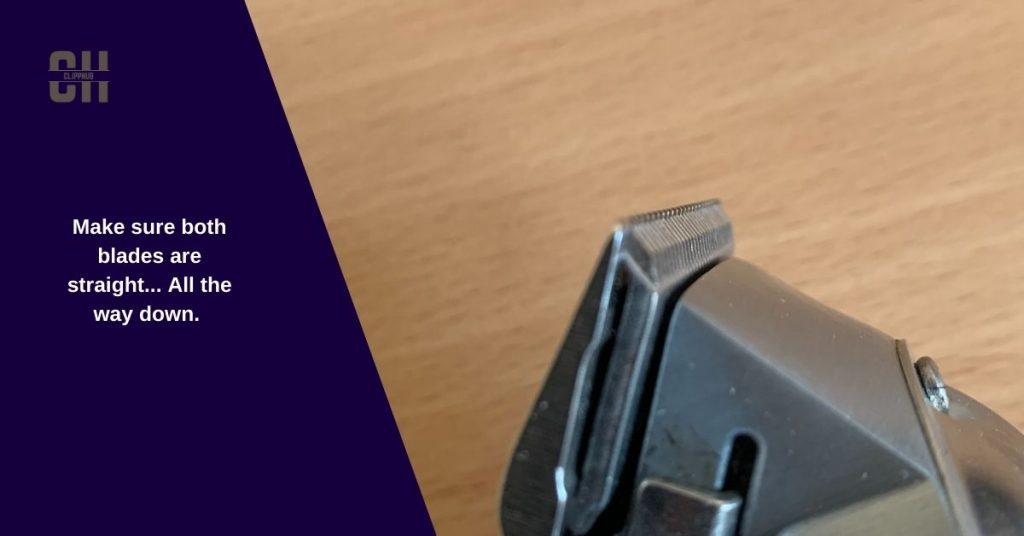
Step 7:
Now tighten the screws and your blades are now fully re-assembled.
Here is the process of putting the blade back together visually:
Now..
Once your blade is back together, you need to oil them to reduce that initial friction.
Testing pressure of the cutting blade
Now you must test the pressure of the blade cutting to make sure it can slide back and forth seamlessly.
Push the cutting blade out of the spring as shown below:

Then push the cutting against a weighing scale and it should take about 2-3 pounds of force to push the cutter back into place. (2.23kg – 1.3kg).
If it doesn’t fall in this range.. don’t stress as long as your blades move smoothly when you press it, you should be fine!
But overall, this is how you know the blade is set in right.
If this is not the case you may need to unscrew the blade slightly to allow more or less pressure onto the cutting blade.
Once the tension on your blade is correct, you can now attach your blade back to your clipper and you can use your clipper once more!
And just like that, your blades are revived.
Conclusion
Now you have been through this article you should know how to sharpen Andis hair clipper blades.
Be sure to always check your blades need sharpening before you remove them as you risk
- Changing the tension on your blade
- Change the alignment of your blade
Always make sure to keep all blade parts safe and untouched after you have removed them. Any damage or change to parts can affect the re-assembly of your blades.
Always align your clippers correctly after sharpening and keep their oil regularly to help your clipper blades last longer and stay sharp.

